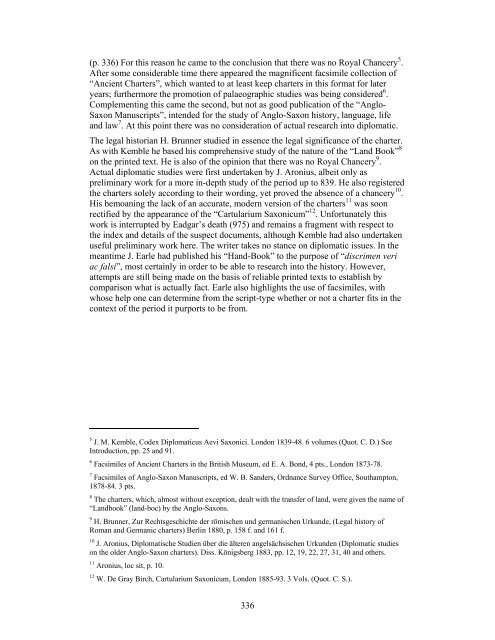Provisional Drogereit pdf
Provisional Drogereit pdf
Provisional Drogereit pdf
Create successful ePaper yourself
Turn your PDF publications into a flip-book with our unique Google optimized e-Paper software.
(p. 336) For this reason he came to the conclusion that there was no Royal Chancery 5 .<br />
After some considerable time there appeared the magnificent facsimile collection of<br />
“Ancient Charters”, which wanted to at least keep charters in this format for later<br />
years; furthermore the promotion of palaeographic studies was being considered 6 .<br />
Complementing this came the second, but not as good publication of the “Anglo-<br />
Saxon Manuscripts”, intended for the study of Anglo-Saxon history, language, life<br />
and law 7 . At this point there was no consideration of actual research into diplomatic.<br />
The legal historian H. Brunner studied in essence the legal significance of the charter.<br />
As with Kemble he based his comprehensive study of the nature of the “Land Book” 8<br />
on the printed text. He is also of the opinion that there was no Royal Chancery 9 .<br />
Actual diplomatic studies were first undertaken by J. Aronius, albeit only as<br />
preliminary work for a more in-depth study of the period up to 839. He also registered<br />
the charters solely according to their wording, yet proved the absence of a chancery 10 .<br />
His bemoaning the lack of an accurate, modern version of the charters 11 was soon<br />
rectified by the appearance of the “Cartularium Saxonicum” 12 . Unfortunately this<br />
work is interrupted by Eadgar’s death (975) and remains a fragment with respect to<br />
the index and details of the suspect documents, although Kemble had also undertaken<br />
useful preliminary work here. The writer takes no stance on diplomatic issues. In the<br />
meantime J. Earle had published his “Hand-Book” to the purpose of “discrimen veri<br />
ac falsi”, most certainly in order to be able to research into the history. However,<br />
attempts are still being made on the basis of reliable printed texts to establish by<br />
comparison what is actually fact. Earle also highlights the use of facsimiles, with<br />
whose help one can determine from the script-type whether or not a charter fits in the<br />
context of the period it purports to be from.<br />
5<br />
J. M. Kemble, Codex Diplomaticus Aevi Saxonici. London 1839-48. 6 volumes (Quot. C. D.) See<br />
Introduction, pp. 25 and 91.<br />
6 Facsimiles of Ancient Charters in the British Museum, ed E. A. Bond, 4 pts., London 1873-78.<br />
7<br />
Facsimiles of Anglo-Saxon Manuscripts, ed W. B. Sanders, Ordnance Survey Office, Southampton,<br />
1878-84. 3 pts.<br />
8 The charters, which, almost without exception, dealt with the transfer of land, were given the name of<br />
“Landbook” (land-boc) by the Anglo-Saxons.<br />
9 H. Brunner, Zur Rechtsgeschichte der römischen und germanischen Urkunde, (Legal history of<br />
Roman and Germanic charters) Berlin 1880, p. 158 f. and 161 f.<br />
10 J. Aronius, Diplomatische Studien über die älteren angelsächsischen Urkunden (Diplomatic studies<br />
on the older Anglo-Saxon charters). Diss. Königsberg 1883, pp. 12, 19, 22, 27, 31, 40 and others.<br />
11 Aronius, loc sit, p. 10.<br />
12 W. De Gray Birch, Cartularium Saxonicum, London 1885-93. 3 Vols. (Quot. C. S.).<br />
336
















